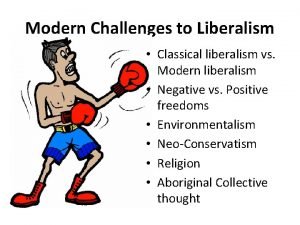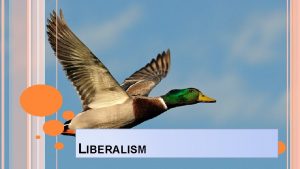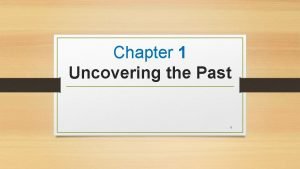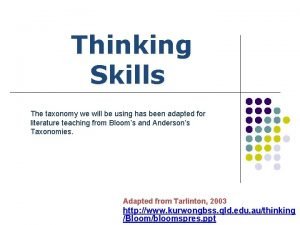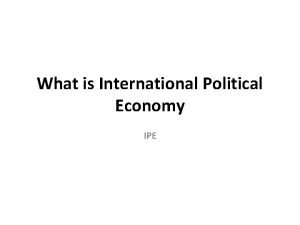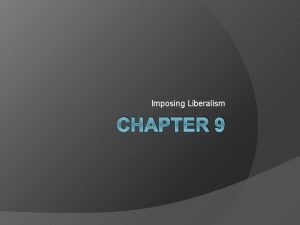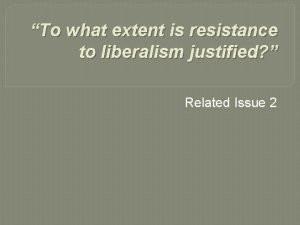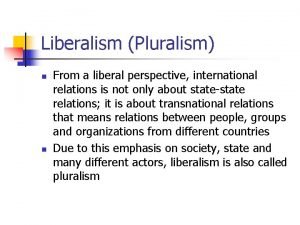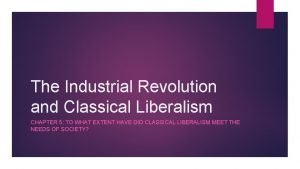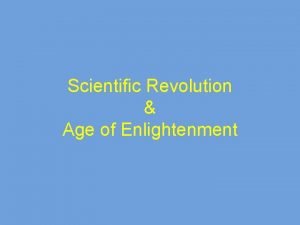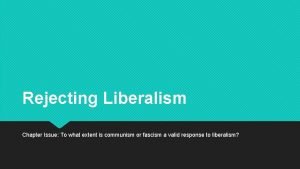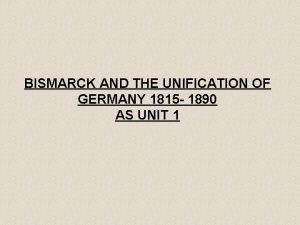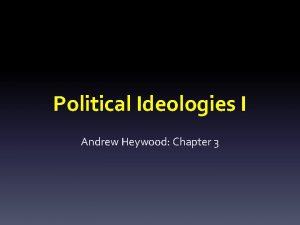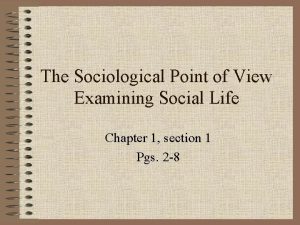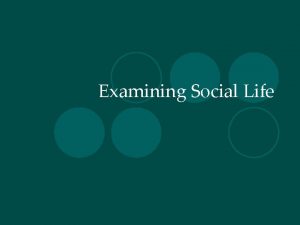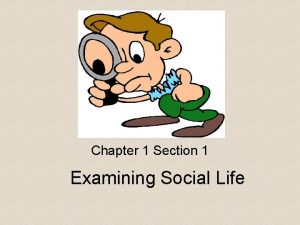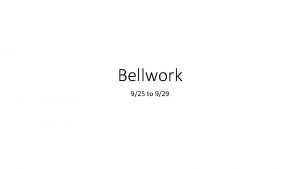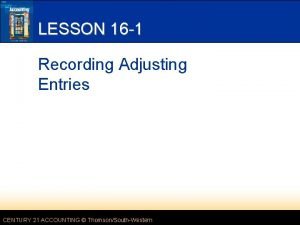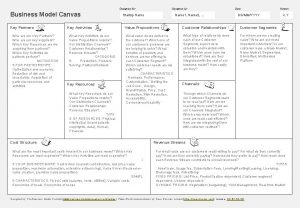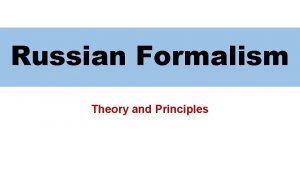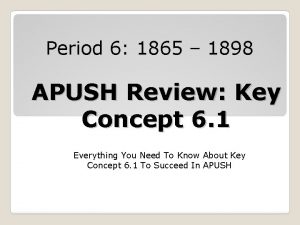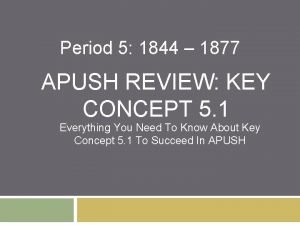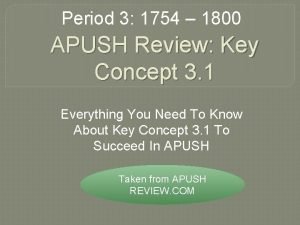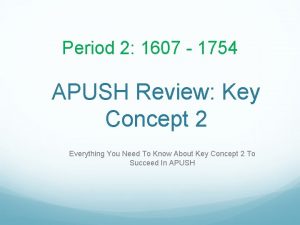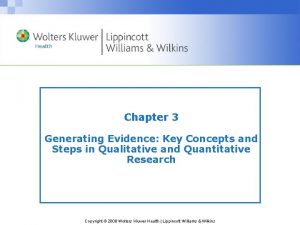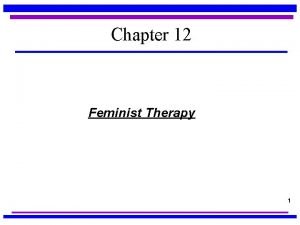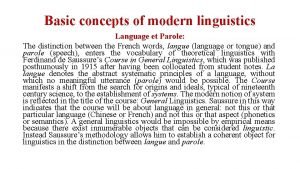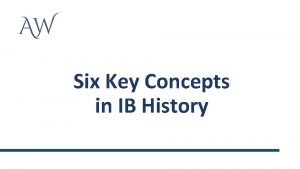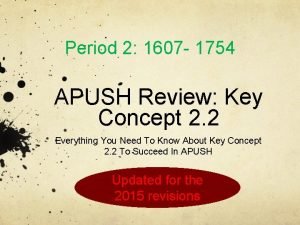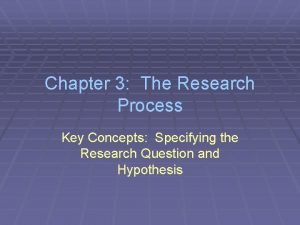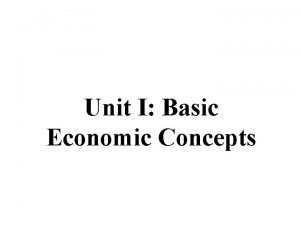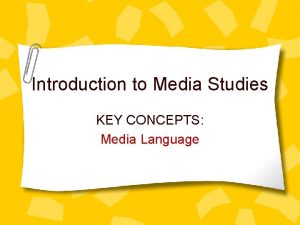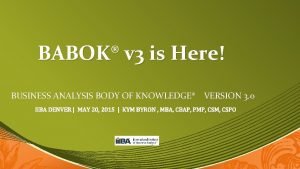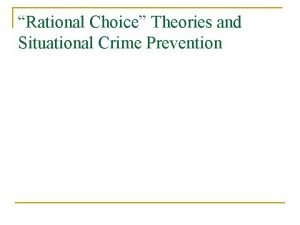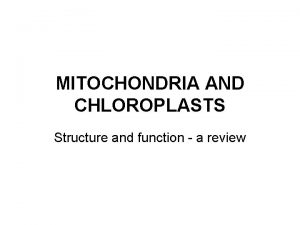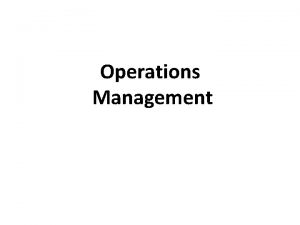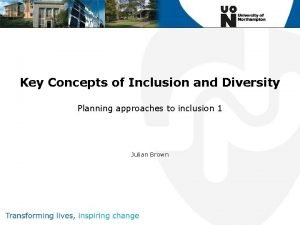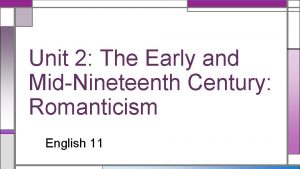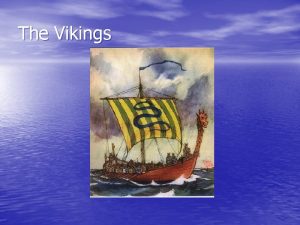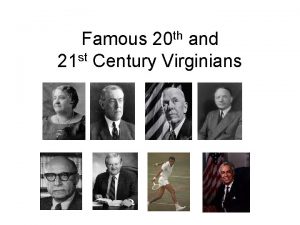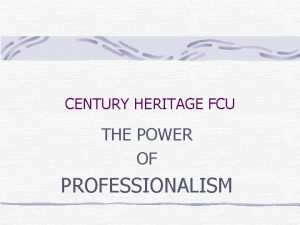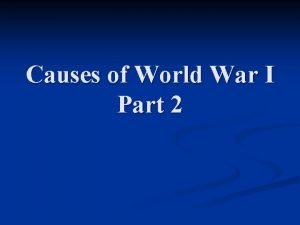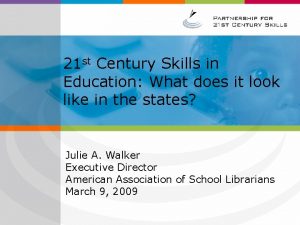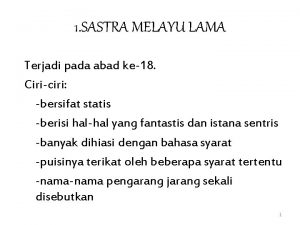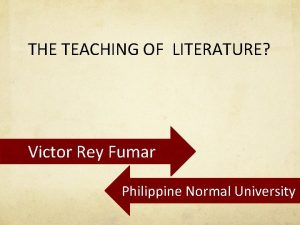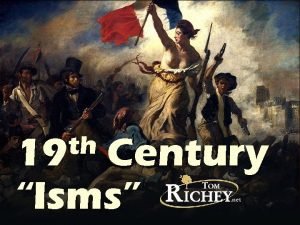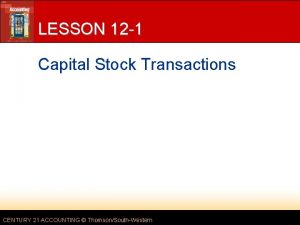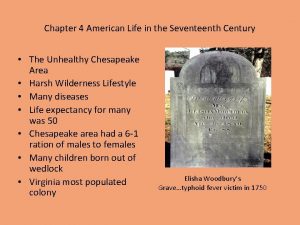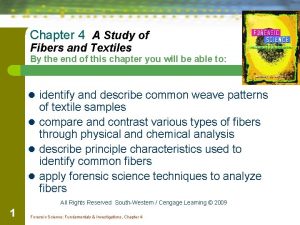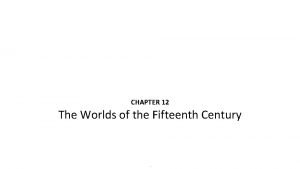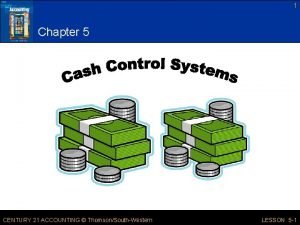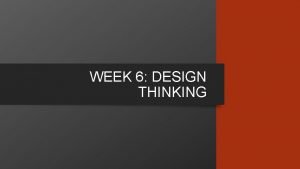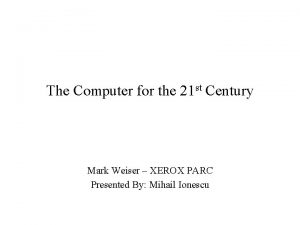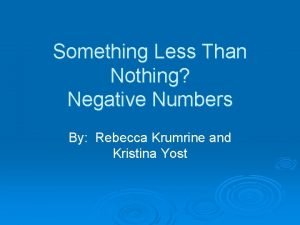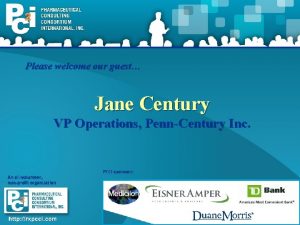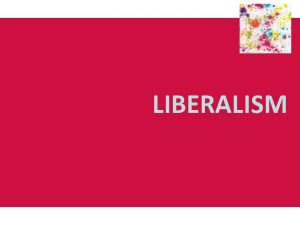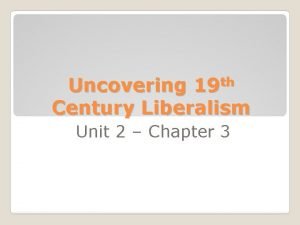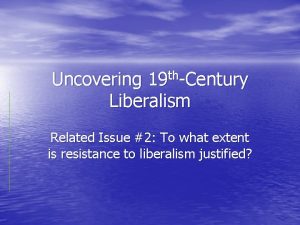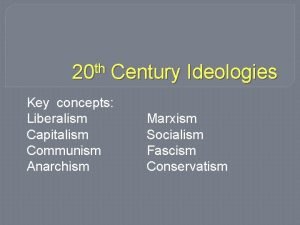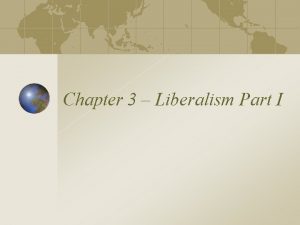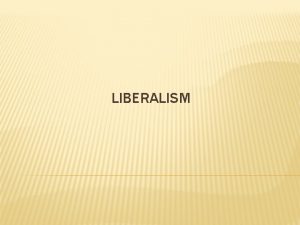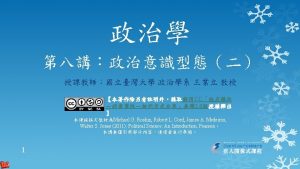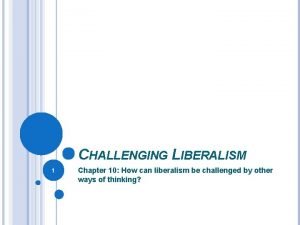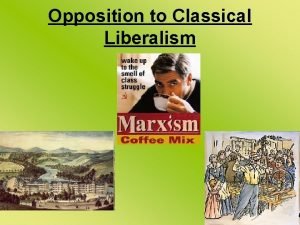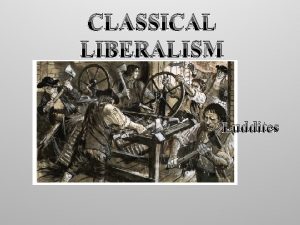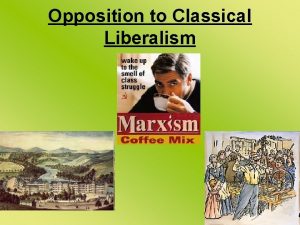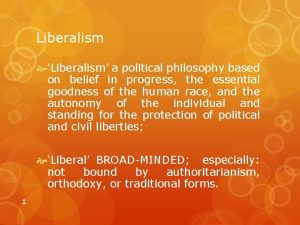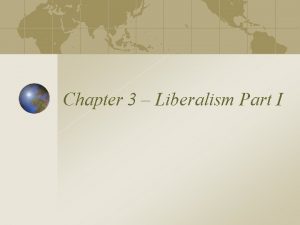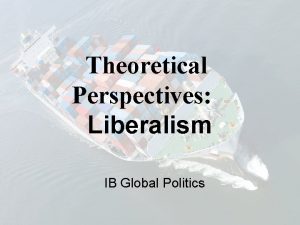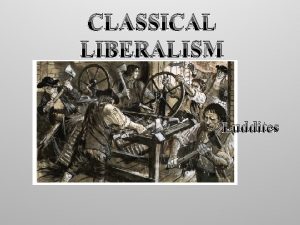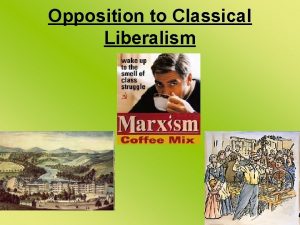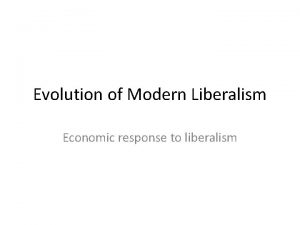Uncovering 19 th Century Liberalism Key Concepts Examining

Uncovering 19 th- Century Liberalism

Key Concepts Examining the history of classical liberalism Analyzing the impact of the evolution of classical liberalism on society

Overview New Ideas about human potential and individual worth Governments friendly to business and innovation Investment capital and cheap labour The free market and limited role for government Laissez-faire capitalism

Key Terms Class system John Locke Enlightenment John Stuart Mill Free market Industrialization Laissez-faire capitalism Limited government Traditional economy Economic Freedom Montesquieu Adam Smith Thomas Hobbes

Timeline that eventually combined to form classical liberalism the five principles of classical liberalism p 105 -106 p 107

The basic principles of Liberalism (which can be applied to the social, economic and political structures of society) Personal freedom: refers to the absence of coercion (force) and includes free speech, religious liberty, the right to private property, and the right to political opposition Equality of Right: all must abide by the same laws, which the government enforces with impartiality Belief in the Rule of Law –no one is above the law. Limited government: means that the state (government) is an instrument serving a function in society. Consent of the governed: Government is responsible to people and may be changed by them

Classical Liberalism liberalism, laissez-faire liberalism stressing individual freedom, free markets, and limited government equality under the law, constitutional limitation of government, free markets , limited government intervention it is the fusion of economic liberalism with political liberalism of the late 18 th and 19 th centuries (the Industrial revolution) classical liberalism is the idea that laissez-faire economics will bring about a spontaneous order or invisible hand that benefits the society traditional

Liberalism Advocates civil rights for all people Equal treatment of all citizens irrespective of race, gender and class. In the USA many social liberals favor affirmative action (a policy designed to redress past discrimination against women and minority groups through measures to improve their economic and educational opportunities)

What forces and beliefs stimulated the development of classical Liberalism? We will explore the history of liberalism. You will examine the societies, events and individuals that contributed to the development of liberalism a major ideology. This will help you to understand why the early forms of liberalism had evolved and have been modified through time.

Creation of Liberal Movement notes Political Aspects Born out of ideas of the philosophers (Enlightenment) Economic aspects Evolved out of the ideas of the industrial revolution The fusion of economic liberalism and political liberalism in the 15 th , 16 th and 17 th centuries (the industrial revolution).

Thinkers whose ideas contributed to the ideology of economic, social and political liberalism Thomas Hobbes John Locke Baron de Montesquieu John Stuart Mill Adam Smith Aboriginal Contributions

1755 Lisbon Earthquake The earthquake and its fallout strongly influenced the intellectuals of the European Age of Enlightenment. Voltaire used the earthquake in satire and in his Poème sur le désastre de Lisbonne ("Poem on the Lisbon disaster"). Voltaire's satirically attacks the notion that all is for the best in this, "the best of all possible worlds", a world closely supervised by a benevolent deity. Qestioning blind faith in god and the fatalism that then-dominant philosophy of “Optimism” engendered The Lisbon disaster provided a salutary counterexample In the later twentieth century, the disaster has been compared to the Holocaust as a catastrophe that transformed European culture and philosophy. Jean-Jacques Rousseau was also influenced by the devastation following the earthquake, whose severity he believed was due to too many people living within the close quarters of the city. Rousseau used the earthquake as an argument against cities as part of his desire for a more naturalistic way of life.

Since the earthquake took place on All Saints’ Day and destroyed most of the city’s major churches, reactionary priests blamed the destruction on Lisbon’s supposed sins. Inquisitors literally roamed the streets looking for heretics to hang. But the grip of the dead hand of the medieval church on society was weakening and eventually broke. Coming at a time when bourgeois forces were growing strong enough to burst the straitjacket of feudalism, the Lisbon disaster played a key role in the Enlightenment, intellectual forerunner for the French Revolution of 1789 -1804.

HISTORY OF CLASSICAL LIBERALISM John Locke Baron Montesquieu John Stuart Mill § Adam Smith Jean-Jacques Rousseau Thomas Hobbes


The Dead Liberal Philosophers: Key Ideas Thinkers Beliefs John Stuart Mill Protection of individual freedom. Protect the liberty of others. How their ideas were radical at that time How their ideas are related to Classical Liberalism Individualism was not Free speech the norm at this time. Society was still hierarchal.

The Dead Liberal Philosophers: Key Ideas Thinkers Beliefs John Lock Opposed authoritarianism of the church and state Individual should make their own decisions “tabula ras” In order to succeed people would need to enter into a social contract, How their ideas were radical at that time Advocated for government accountability to the people- something quite uncommon at the time. How their ideas are related to Classical Liberalism give up some natural rights to a government in order to receive order and security

The Dead Liberal Philosophers: Key Ideas Thinkers Beliefs Adam Smith Everyone would work for themselves and thus benefit society. State efforts to promote social good are ineffectual. How their ideas were radical at that time How their ideas are related to Classical Liberalism Countered the Free market dominated system mercantilist system of Book Wealth of the time(which nations promoted the power and wealth of the state but with only a few people enjoying this power and wealth. A free market and limited governmental role in the economy were new and controversial ideas.

The Dead Liberal Philosophers: Key Ideas Thinkers Beliefs How their ideas were radical at that time Baron Montesquieu Believed in the worth of the individual and equality of individuals. People need to be involved in Gov. Desired the elimination of the French Monarch system, to be replaced with a more equitable, accountable & separate system of government where citizens would have much more say and protection How their ideas are related to Classical Liberalism Accountability of the government Separation of powers

The Dead Liberal Philosophers: Key Ideas Thinkers Beliefs How their ideas were radical at that time How their ideas are related to Classical Liberalism A Philosopher with Opposing Views Thomas Hobbes All people will give up some of their sovereignty by handing over power to the state Individuals are selfish and it’s self-interest that is the root of social conflict. Move power from individuals to governing authority as long as this ruler kept their citizens safe, the could overthrow them and find another leader Security of all individuals and the worth of the individual.

Identify principles of Liberalism Assignment The term liberalism has had different meanings to historical and contemporary contexts. Despite the changes over time, liberalism as an ideology has retained some core principles and values that reflect a particular view of human nature and the role of governments in society Word document Compare one historical philosopher from group A and one contemporary figure from group B Identify principles of liberalism that have remained constant over time. Make sure to compare and contrast the two writers following the principles and values of liberalism P R I C E

Group A Historical John Locke Keynesian John Stuart Mill federalist) Jeremy Bentham (social reformer) Adam Smith (economist FDR Montesquieu Iroquois Confederacy Group B Contemporary James Tobin (economist) Pierre Trudeau (liberalism Tommy Douglas (NDP) John Kenneth Galbraith supporter) John Maynard Keynes John F. Kennedy Milton Friedman Chief Clarence Louis

Creation of the Liberal Movement Economic Aspects Evolved out of the ideas of the industrial revolution

Laissez-Faire Economics Traditional economy; based on subsistence farming in rural areas, which shifted to factories and urban centers. Mercantilism is an economic theory that there is a fixed amount of wealth in the world and that a nation's prosperity depends on its success in accumulating wealth by exporting more than it imports. European nations of the 17 th-19 th centuries attempted to put it into effect through commercial policies designed to produce a favorable balance of trade, through acquisition and development of colonies as exclusive markets and sources of raw materials. D: sourcemmm 2ss 30_1_m 2_004. ht ml

The influence of Liberalism on Capitalism Economic freedom, individual freedom, private property and completion. Technological developments led to mechanization as individual entrepreneurs and inventors tried to be more efficient and profitable. Innovation flourished

Economic Policy (a shift) Mercantilism The goal is for the nation and the monarch to acquire as much wealth as possible. There is very little competition. Nations exploit other, smaller countries. The government has the power to intervene in the economy. Capitalism There is open competition Private property is guaranteed. There is economic freedom It is believed that selfinterest will make the nation profitable. The power of the government ito intervene in the economy is limited.

Economic Change 1776 Wealth of Nation (Scottish Economist Adam Smith build on the physiocrat’s ideas of Laissez-fair economics) The invisible hand is most often assumed to work is the free market. Adam Smith assumed that consumers choose for the lowest price, and that entrepreneurs choose for the highest rate of profit. He asserted that by thus making their excess or insufficient demand known through market prices, consumers "directed" entrepreneurs' investment http: //www. youtube. com/watch? v=c. D 0 dm. RJ 0 o. Wg&fe money to the most profitable ature=related Michael Moore schooled on economics by Milton Friedman industry.

Smith Believed People instinctively see what is best for them Self-interest should be freely expressed in an environment of unlimited competition: (a free market system) Natural interplay between buyers and sellers and workers and employers would ultimately insure that goods were produced efficiently and economically. Government meddling in the economy not be necessary. Competition between consumers for products, between businesses for consumer dollars, between workers for jobs, and between employers for skilled workers would make the economy regulated. Process is known as the invisible e hand. As individuals strove to better their own economic situation, the economy of the nation as a whole wold also benefit.

Invisible Hand Man is motivated by self-interest

Basics of Liberal Democracy worksheet principles of Liberal Democracy, complete worksheet and hand in. Use pg. 71 -79 and 105 -107 Characteristic or Basic Principle of Liberal Democracy Brief description (in your own words) A real or Theoretical Example of this Characteristic or principle An opposite or Non-Example of this characteristic of liberal democracy Rule of law means that all people in a society are subject to the same laws, regardless of their wealth, position in society (legal or political) If a prime minster is found to be driving impaired he or she would be charged and put on trial like any other person. A royal prince murders another person but is not charged because his father is king.

Ideological Perspectives under Liberalism Handout on ideology / spectrums file: ///D: /source/mm/m 2/ss 30_1_m 2_001. html (remember need disk in computer) Check your understanding by evaluating the following cartoons. file: ///D: /source/mm/m 2/ss 30_1_m 2_002. html

Proponents of Liberalism John Locke and John Stuart Mill believed human beings are equal and independent. They believed that humans have certain inalienable rights such as the right to life, liberty, equality and ownership of property.

Conservatism The belief that individuals and society have a moral responsibility to respect past traditions, customs and habits. ( Status Quo” When individuals and society wish to make reforms, they must be slow and gradual. Belief that society should be structured in a hierarchical fashion.

Proponent of Conservatism Edmund Burke believed society should be structured in a hierarchy with those best suited to leadership at the top, because people do not have equal abilities. Government should be chosen by a limited electorate with special rights, responsibilities, and privileges.

Thinkers whose ideas contributed to the ideology of Liberalism p. 102 -112. Handout Thinkers Beliefs How their ideas were radical at that time How their ideas are related to Classical Liberalism Hobbes All people will give up some of their sovereignty by handing over power to the state Move power from individuals to governing authority as long as this ruler kept their citizens safe, the could overthrow them and find another leader Security of all individuals and the worth of the individual. Locke Opposed authoritarianism of the church and state Advocated for government accountability to the peoplesomething quite uncommon at the time. give up some natural rights to a government in order to receive order and security Montesquieu Believed in the worth of the individual and equality of individuals Desired the elimination of the French Monarch system, to be replaced with a more equitable, accountable & separate system of government where citizens would have much more say and protection Accountability of the government Separation of powers Smith Everyone would work for themselves and thus benefit society Countered the dominated mercantilist system of the time(which promoted the power and wealth of the state but with only a few people Free market system Book Wealth of nations

TO SUM UP Liberalism can be applied to the broad set of values associated with democracy. The word liberal is associated with a narrower interpretation of how those values should be implemented. At the other end of the political spectrum is the conservative interpretation of how a liberal democracy should function

Summary of What We Have Looked At What forces and beliefs stimulate the development of classical liberalism. You examined philosophers’ who contributed to classical liberalism. Classical liberalism emphasized the political power of the people and the importance of individual liberty. Classical liberalism also limited government intervention in the economy Classical liberal philosophers tended to focus heavily on the freedom to make money

EXPLAINING LIBERALISM TO OTHERS YOUR TASK Present in a unique and engaging way the information you have learned so far about liberalism. Spoof on liberalism Google hinterland who's who spoofs Create a spoof of your own. Your public service advertisement will describe the family of “creatures” known as “Liberalists” (libertas patronus) and the major subsets or subspecies who exist within that larger family. Be sure to provide information about identifying characteristics, typical habits, natural enemies, and so on. Final format can be a short video, a podcast, a narrated slide show, an audio recoding or a series of posters

How Did Liberalism Originate? The challenges of classical liberalism! When put into practice there were both positive and negative impacts. Societies adapted classical liberalism To meet the challenges created by unrestricted laissez-fair capitalism. The question is why did classical liberalism change?

What do these points of view have in common? Where do they differ? Both reflect the conditions of the working class. Dickens: Negative view of the I. R. & its impact on workers; deplorable state of the cities & oppressive social & working conditions. Ricardo: Positive view; as he sees the laws of economics at work. His view is based on laissez-faire capitalism

Historical Development of European Ideas And Events That Combined to Form Classical Liberalism. Significant Historical Events Through Paintings and pictures Political change: the government of the day was lacking in the ability to govern, therefore policy changes had to be enacted by a new administration.

The Evolution of Classical Liberal Thought

American Declaration of Independence 1776

The Storming of the Bastille http: //www. youtube. com/watch? v=-z. PTFGLHav. Q

The French Revolution The Storming of the Bastille Nationalist movement Liberal movement Rejected divine right of kings In favour of rule by a government of people. Replaced a social and governmental system on heredity and privilege with a system based on equality. http: //www. youtube. com/watch? v=-z. PTFGLHav. Q

Quotes about Liberalism and the French Revolution Jean-Jacques Rousseau 1712 - 1778 How is each quote an example of Liberalism? "Man was born free, and everywhere he is in chains. “ I prefer liberty with danger than peace with slavery” “To renounce liberty is to renounce being a man, to surrender the rights of humanity and even its duties” Force does not constitute right. . . obedience is due only to legitimate powers. ” “Liberty is obedience to the law which one has laid down for oneself”


Test your understanding (see chart next page) Using a chart format, connect each of the six principles of classical liberalism listed on p. 105 with the eight sections of the Declaration of the Rights of Man and of citizens listed on p. 115 and 118.

Connect Classical Liberalism and the Declaration of the Rights of Man Principles of Classical Liberalism The Declaration of the Rights of Man and of the Citizen

American Revolution 1776 Washington Crossing the Delaware. December 25, 1776, during the American Revolutionary War. It was the first move in a surprise attack against the British forces

The American Revolution 1776 The American Revolution refers to the political upheaval during the last half of the 18 th century in which thirteen of Britain's colonies in North America overthrew the governance of the Parliament of Great Britain, and then rejected the British monarchy itself to become the sovereign United States of America. In this period the colonies first rejected the authority of the Parliament to govern them without representation, and formed self-governing independent states.

Anti Vietnam War Demonstration

To what Extent did Aboriginal Ideas Influence Liberalism in North America Read p. 116 Based on the sources, what evidence is provided to support the idea that the Great Law of Peace may have an influence on the American Constitution?

Check your understanding P. 117 What specific aspects of liberalism were built on and or adopted by these individuals in the American revolution? How would the comments be interpreted by various groups in American colonial society? Examine the Canadian Charter of Rights and Freedoms to determine the extent to which liberal principles influenced the writers of Canada’s constitution.

LIBERALISM ØStresses civil rights for all people (individual rights and freedom of choice) ØIncludes the idea of decentralized ØFaith in human progress Ø Equal treatment of all citizens irrespective of race, gender and class. Ø In the USA many social liberals favor affirmative action.

Liberal Principles in Action The Industrial Revolution created much wealth for society overall and made liberal reforms possible. Prior to that, societies often could not affords the costs of banning child labor, providing public education, implementing worker safety laws, providing welfare, health care, and old age care, etc.

The Influence of Liberalism on Capitalism Economic freedom, individual freedom, private property and competition. Technological developments led to mechanization as individual entrepreneurs and inventors tried to be more efficient and profitable. Innovation flourished.



Before the Enclosure Movement

Inventions of the Industrial Revolution

Pressure was accompanied by the Liberal beliefs in the sanctity of private property Fewer agricultural labourers were needed on mechanized farms; thus farmers became a large workforce for then new factories.


Jethro Tull’s Seed Drill

Cyprus Hall Mc. Cormick 1831 mechanical reaper Greatly increased harvesting crops.

John Kay 1733 Flying Shuttle, Automation of textile making in the A. R.

Spinning Jenny James Hargreaves 1764 http: //www. google. ca/imgres? q=james+hargreaves+spinning+jenny&hl=en&gbv=2&biw=1280&bih=598&tbm=isch&tbnid=DEgf 6 Kfl. Bmyr. M: &imgrefurl=http: //www. timetoast. com/flash/Timeline. Viewer. swf%3 Fpassed. Timelines%3 D 89905&docid=8 s. QEVae. YXq 0 Op. M&imgurl=http: //s 3. timetoast. c om/public/uploads/photos/1144741/spining_jenny_2. jpg%253 F 1289238142&w=640&h=474&ei=M 5 Po. T 7 eb. KYGo 2 w. Xr 9 za. CQ&zoom=1&iact=hc&vpx=472&vpy=287&dur=344&hovh=193&hovw=261&tx=81&ty=97&sig=112969002459040774130&page=2&tbnh=129&tbnw=174&s tart=20&ndsp=26&ved=1 t: 429, r: 15, s: 20, i: 181

James Watt’s improved steam engine powers the I. R

1779 Samuel Crompton Spinning mule

1785 Power Looms


Shift from Domestic System to the Factory The factory system developed in the late eighteenth century, system chiefly due to the advances being made in the textile Workers received the raw materials, take them home and build whatever was required, and then return the finished product. Virtually all work was done by hand, in much the same way that it had always be done since the time of the Romans. Usually work was done in the labourer’s own home industry. With inventions such as the flying shuttle, the spinning jenny and many others, the making of cloth became much faster, and could be done on a much wider scale. Hand weavers were driven out of business by bit new factories, which they were later forced to work in. These factories were first run by water, then by steam, and their output greatly improved the nation’s economy. Instead of one worker completing an item, such as a length of material, a variety of machines made the fabric. Also, instead of one worker following the same piece of material from raw wool to dyed cloth, each worker concentrated on only one task. The “assembly-line” approach was very efficient, however the tasks became extremely monotonous and repetitive. Working conditions were also very poor. Factory laboursmainly young children-had to put in extremely long hours, were very poorly paid, and worked in dangerous and violent surroundings. During the first part of the industrial Revolution there were no laws to protect workers, and even when a few were passed they were rarely followed.

Compare and contrast Cottage and Factory System Similarities Cottage System Factory System

Commercial and Industrial Revolutions Development of a money economy and the development of financial institutions Discredited the government-regulated Mercantile system (Mercantilism suggests that the ruling government should advance economic goals by playing a protectionist role in the economy; by encouraging exports and discouraging imports, notably through the use of tariffs and subsidies. ) in favor of free trade. Commercial entrepreneurs emerged with trading merchants.

The Industrial Revolution’s Impact on 19 th century Society Read p. 122 Figure 3 -13 Answer the three questions associated with this image. Answer: factory owners, bankers and lawyers reaped the benefits of leadership Laborers who worked in factories were overworked and paid low wages Excessive number of laborers due to the agricultural revolution; so wages were low. Adam Smith: the free market for the exchange of goods and services was seen as necessary despite poor working conditions To intervene would upset the normal operations of the capitalist system.

IDUSTRIAL REV. IMPACT ON 19 TH CENTURY SOCIETY Change in class structure Laissez-faire gov. A move from aristocratic class to a new class of entrepreneurs‘, professionals, financiers (industrial efficiency) Middle class Working class http: //www. youtube. com/watch? v=S 4 Kr. IMZpw. CY Model T

Women and the Industrial Revolution What might explain the different views provided by each source? Do you think woman were better off during the Industrial Revolution based on these two sources? To what extent do these sources reveal the impact of liberalism on society?

Answers to pg. 123 First source: retrospective look from a 21 st century view. Positive aspects. General commentary on woman Second source: testimony given to a government commission in 19 th century England. Negative aspects. First hand account.

Industrial Reform 1833 The Factory Act: limited the working day for children 1842 The Mines Act: barred employers from hiring women to work in mines and made 13 the minimum age for children

Concept Review/Liberalism in the Industrial revolution A growing emphasis on individual rights and freedoms; especially for the middle class, but later for the labouring class as they began to demand more equitable treatment through government legislation. Minimal government intervention Enclosure ( private property) crated a large labour force for the rising industrialization. Freer trade, capital was created, allowing for the construction of factories

To What extent can classical liberalism impact a society? What factors were most important in bringing about the emergence of classical liberalism While exploring the Western European origins of liberalism, consider that many people who believed in liberalism during this time believed that: Individual freedoms and rights would be protected Nobody should be above the law What is good for individuals within community can also be good for the community as a whole Most individuals, if left alone, will make good decisions for themselves as well as their communities. Government intervention should be limited so as to allow individuals as much freedom of choice about their lives a possible. Individuals and companies should be allowed to create, market, purchase, and sell products with a minimum of government intervention (in free market economy)

Illiberalism An illiberal democracy is a governing system in which, although elections take place, citizens are cut off from knowledge about the activities of those who exercise real power because of the lack of civil liberties. It is not an “open society”. This may be because a constitution limiting government powers exits, but its liberties are ignored, or to the simple absence of an adequate legal constitutional framework of liberties.

Illiberal democratic governments may believe they have a mandate to act in any way they see fit as long as they hold regular elections. Lack of liberties such as freedom of speech and freedom of assembly make opposition extremely difficult. The rulers may centralize powers between branches of the central government and local government (having no separation of power). Media is often controlled by the state and strongly support the regime. Non-governmental organizations may face onerous regulations or simply be prohibited. The regime may use red tape, economic pressure violence against critics.

illiberalism Elections take place Citizens are cut off from knowledge Hold regular elections Centralize powers Absence of an adequate legal constitutional framework of liberties Media is often controlled by the state Lack of civil liberties Red tape Not a open society No separation of powers Economic pressure or violence against critics Lack of liberties freedom of speech and assembly NOG’s onerous regulations

Illiberalism Assignment Reading: Democracy starts with the rule of Law Give examples from the reading of illiberal elected governments Is there a relationship between elections and democracy: give examples “the absence of the rule of law constitutes the most serious problem” explain.

Classical Liberalism Modern Liberalism Interested in protecting the freedom of individuals in the economic realm Interested in creating equality of opportunity for all individuals Maximum rights and freedom for certain individuals (entrepreneurs) Freedom and rights favour the individual, with more individuals in society receiving rights. Government rules, regulations (e. g. minimum wage). , and social programs (e. g. health care, old-age pensions, employment) Government intervenes to ensure that the most vulnerable people (e. g. sick, elderly, unemployed, working poor) are cared for.

Liberalism Today Liberals today generally believe today that every individual is unique. The purpose of life is to realize that potential, and to become whatever it is one is capable of becoming. The role of the state (government) is to produce the conditions under which individuals have the broadest possible choice in deciding upon their definition of good. Society, meanwhile, should celebrate this diversity while giving equal treatment to all, regardless of a person’s origins, colour, sex or status in life. In exchange for this respect, the individual must acknowledge responsibility for his own fortunes and for the fortunes of the community.

Anti Vietnam War Demonstrations

Kosovo Newborn http: //www. youtube. com/watch? v=Fg 5 CDd. LGGb. I&feature=rel ated

Call centres are examples of outsourcing

Trading Blocs such as NAFTA

END

What makes History Significance Your task: as you read each; excerpt on p. 125, think about the consequences each author is examining. Rank the excerpts from most significant to least significant, providing reasons why you put the excerpts in that order. Use the questions to guide you for assistance. P. 126

What Makes History Significant? Source Points of view (political, economic or social) Rational Purpose
- Slides: 94
